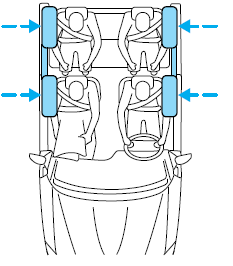 Ford Escape: How does the Safety Canopy System work?
Ford Escape: How does the Safety Canopy System work?
The design and development of the Safety Canopy system included recommended testing procedures that were developed by a group of automotive safety experts known as the Side Airbag Technical Working Group. These recommended testing procedures help reduce the risk of injuries related to the deployment of side airbags (including the Safety Canopy ).
The Safety Canopy system consists of the following:

• An inflatable curtain with a gas
generator concealed behind the
headliner and above the doors
(one on each side of vehicle).
• A headliner designed to flex open
above the side doors to allow Safety Canopy deployment.
• The same warning light, electronic control and diagnostic unit as used
for the front airbags.
• Two crash sensors mounted at lower B-Pillar (one on each side).
• Two crash sensors located at the C-pillar behind the rear doors (one
on each side).
• Rollover sensor in the restraints control module (RCM).
The Safety Canopy system, in combination with safety belts, can help reduce the risk of severe injuries in the event of a significant side impact collision or rollover event.
Children 12 years old and under should always be properly restrained in the second or third row seats. The Safety Canopy will not interfere with children restrained using a properly installed child or booster seat because it is designed to inflate downward from the headliner above the doors along the side window opening.
The Safety Canopy system is designed to activate when the vehicle sustains lateral deceleration sufficient to cause the RCM to initiate Safety Canopy inflation or when a certain likelihood of a rollover event is detected by the rollover sensor.
The Safety Canopy is mounted to roof side-rail sheet metal, behind the headliner, above the first and second row seats. The Safety Canopy is designed to inflate between the side window area and occupants to further enhance protection provided in side impact collisions and rollover events.
The fact that the Safety Canopy did not activate in a collision does not mean that something is wrong with the system. Rather, it means the forces were not of the type sufficient to cause activation. The Safety Canopy is designed to inflate in certain side impact collisions or rollover events, not in rear impact, frontal or near-frontal collisions, unless the collision causes sufficient lateral deceleration or rollover likelihood.
![]() WARNING: Several Safety
Canopy system components
get hot after inflation. Do not
touch them after inflation.
WARNING: Several Safety
Canopy system components
get hot after inflation. Do not
touch them after inflation.

![]() WARNING: If the Safety Canopy system has deployed, the
Safety Canopy will not function again unless replaced. The
Safety Canopy system (including the A, B, C, and D pillar trim and
headliner) must be inspected and serviced by an authorized dealer. If
the Safety Canopy is not replaced, it will not function again, which will
increase the risk of injury in a future collision.
WARNING: If the Safety Canopy system has deployed, the
Safety Canopy will not function again unless replaced. The
Safety Canopy system (including the A, B, C, and D pillar trim and
headliner) must be inspected and serviced by an authorized dealer. If
the Safety Canopy is not replaced, it will not function again, which will
increase the risk of injury in a future collision.
 Safety Canopy System
Safety Canopy System
WARNING: Do not place
objects or mount equipment
on or near the headliner at the
siderail that may come into
contact with a deploying Safety
Canopy . Failure to follow these
instructions may in ...
 Determining if the system is operational
Determining if the system is operational
The SRS uses a readiness light in the instrument cluster or a tone to
indicate the condition of the system. Refer to Warning lights and
chimes in the Instrument Cluster chapter. Routine maintenance ...
See also:
Cleaning the sensors
Location of the front sensors
Location of the rear sensors
The sensors must be cleaned regularly to
ensure that they work properly. Clean them with water and a suitable car washing
detergent ...
Scan
The function automatically searches the current
waveband for radio stations. When a station
is found, it is played for several seconds
before scanning is resumed. While the station
is playing ...
Parking lamp/standing lamp
Switch off the lights.
Open the hood.
Remove the headlamp cover ().
Left-hand headlamp: detach the washer fluid reservoir ().
Turn housing cover 1 counter-clockwise and pull it out.
Pul ...
